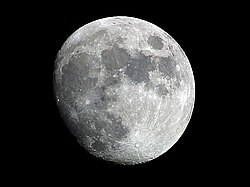Wicigeonga Sunnlicu Endebyrdnes/Mōna
| en:Image:Moon_symbol.ant.png | Moon Facts |
| |

How big is the Moon?
Se Mōna is 3,476 km on wīde.[1] Wiþmeten tō Eorðan is se Mōna swīðe micel. Mǣst ōðerra planētena sind swīðe brǣdran þonne hira mōnan. For þǣm hæfþ man þā Eorðan mid þǣm Mōnan genemned swā twifeald planēta.[2]
- Bysen:Anbhttp://www.nineplanets.org/luna.html; http://www.solarviews.com/eng/moon.htm
- Bysen:Anbhttp://www.esa.int/SPECIALS/SMART-1/SEMO1VMKPZD_0.html; http://www.windows.ucar.edu/tour/link=/earth/moons_and_rings.html&edu=high
What is its surface like?
left|thumb|300px|Astronaut Harrison Schmitt collecting lunar samples during Apollo XVIIThe Moon does not have any atmosphere or water.[3] During the day it becomes very hot. At night it grows icy cold.[4] A person going to the Moon needs an air supply and a special suit.
The Moon has many craters. The largest one is the South Pole-Aitken Basin, located on the far side. It is 2,250 km across.[5] Some of the younger craters have bright rays around them. They were made by material thrown up by the impacts that made the craters.[6]
There are dark areas called maria. They are soldified lava flows that filled up large craters long ago. Most maria are on the near side.[7] There are also lighter-colored highlands.[8]
There might be water ice in the floors of craters near the south pole. The bottoms of those craters are always dark because they are in the shadows of the crater rims. The ice came from comets that hit the Moon.
- Bysen:Anbhttp://www.nineplanets.org/luna.html; http://www.solarviews.com/eng/moon.htm
- Bysen:Anbhttp://www.solarviews.com/eng/moon.htm; http://solarsystem.nasa.gov/planets/profile.cfm?Object=Moon&Display=Facts
- Bysen:Anbhttp://www.nineplanets.org/luna.html; http://www.guinnessworldrecords.com/content_pages/record.asp?recordid=45870&Reg=1
- Bysen:Anbhttp://web.archive.org/web/20020103053413/http://www.space.com/spacewatch/moon_guide-2.html
- {anb|Maria}}http://www.nineplanets.org/luna.html; http://www.solarviews.com/eng/moon.htm
- Bysen:Anbhttp://www.windows.ucar.edu/tour/link=/kids_space/moon_awaits_2.html
How long is a day on the Moon?
It takes the Moon 27.3 Earth days to rotate once.
How long is a year on the moon?
The moon also takes 27.3 days to orbit once around the Earth. So, the Moon always keeps the same side faced towards Earth. That side is called the near side. It is the side with lots of maria. The other side is the far side. Nobody saw the far side until it was photographed in 1959.
What is it made of?
The silicate crust is about 60 km thick on the near side and 100 km thick on the far side. It is thinner under the maria and thicker under the highlands. It is thought that the near side has more maria than the far side because the thinner crust made it easier for lava to flood craters. There is a silicate mantle and a small core 600 to 850 km across.
No one knows exactly how the Moon was made, although scientists have several theories. Some scientists think that the Moon was made very early in the life of Earth (when the Earth was about 50 million years old). A planet about as big as Mars hit the young Earth. The collision had so much energy that the Mars-sized planet was completely destroyed. Also much of the Earth's crust and mantle was vaporised. Some of the debris formed a ring around the Earth and eventually was pulled together by gravity to form the Moon. The rest of the colliding planet and young Earth merged to become the modern Earth.
All this happened billions of years ago. The idea was suggested by things like the small size of the Moon's core and comparisons of what the Moon and Earth are made of.
How much would the Moon's gravity pull on me?
Gif þu wǣre on þǣm Mōnan, it would pull you down with a force about one sixth as strong as the force of Earth's gravity. This allowed the people who visited the Moon to lift rocks that they could not lift as easily on Earth.
For hwǣm is hē genemned?
thumb|right|100px|Sēo gyden Diane, ēac cūþ swā sēo Mōnangyden in Rōmāniscre lāre Mōna and Mōnaþ bēgen cumaþ of þǣm ilcan worde Mōna. Mōnandæg folgaþ Sunnandæge swā se Mōna folgaþ þā Sunnan. In manigum sprǣcum brȳcþ man þone Lǣdenan naman Lunar, swā þæt on Frencisce is se nama Mōnandæg Lundi gehāten.
Other names had been used for the Moon such as Selene and Luna. Selene is the Greek goddess of the Moon. Luna is the Roman name of the same goddess. Diana, a goddess in Roman mythology, is also usually associated with the Moon.